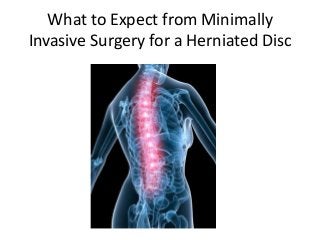Minimally Invasive Surgery for a Herniated Disc
•Als PPTX, PDF herunterladen•
1 gefällt mir•1,192 views
Melden
Teilen
Melden
Teilen

Empfohlen
Empfohlen
Weitere ähnliche Inhalte
Empfohlen
Empfohlen (20)
Product Design Trends in 2024 | Teenage Engineerings

Product Design Trends in 2024 | Teenage Engineerings
How Race, Age and Gender Shape Attitudes Towards Mental Health

How Race, Age and Gender Shape Attitudes Towards Mental Health
AI Trends in Creative Operations 2024 by Artwork Flow.pdf

AI Trends in Creative Operations 2024 by Artwork Flow.pdf
Content Methodology: A Best Practices Report (Webinar)

Content Methodology: A Best Practices Report (Webinar)
How to Prepare For a Successful Job Search for 2024

How to Prepare For a Successful Job Search for 2024
Social Media Marketing Trends 2024 // The Global Indie Insights

Social Media Marketing Trends 2024 // The Global Indie Insights
Trends In Paid Search: Navigating The Digital Landscape In 2024

Trends In Paid Search: Navigating The Digital Landscape In 2024
5 Public speaking tips from TED - Visualized summary

5 Public speaking tips from TED - Visualized summary
Google's Just Not That Into You: Understanding Core Updates & Search Intent

Google's Just Not That Into You: Understanding Core Updates & Search Intent
The six step guide to practical project management

The six step guide to practical project management
Beginners Guide to TikTok for Search - Rachel Pearson - We are Tilt __ Bright...

Beginners Guide to TikTok for Search - Rachel Pearson - We are Tilt __ Bright...
Unlocking the Power of ChatGPT and AI in Testing - A Real-World Look, present...

Unlocking the Power of ChatGPT and AI in Testing - A Real-World Look, present...
Minimally Invasive Surgery for a Herniated Disc
- 1. What to Expect from Minimally Invasive Surgery for a Herniated Disc
- 2. For many people, minimally invasive surgery for a herniated disc represents their best chance for lasting pain relief without undergoing a highly invasive open spine operation. In recent years, with the rapid advancement of endoscopic technology, lasers, and other medical technology, these types of procedures have become more ubiquitous. Now, a procedure that might have previously required months of rehabilitation can be done on an outpatient procedure. However, with all of that said, it is important to understand that any type of surgical procedure should still be considered the treatment of last resort and is only recommended when all other nonsurgical techniques are exhausted.
- 3. A Brief Overview of the Spinal Anatomy The spinal column in the back and neck is responsible for facilitating the full range of motion that we often take for granted during the course of the day. Each vertebra in the spinal column is separated by intervertebral discs, connected by vertebral facet joints, and supported by various muscles groups, ligaments, and tendons. The problem with the spinal anatomy is that it is susceptible to deteriorating as an individual ages. This is why most people associate minor aches and pains and a discernible loss of flexibility with the natural aging process. However, occasionally this normal deterioration can turn into a degenerative spine condition, which may warrant treatment in order to alleviate the patient’s discomfort.
- 4. What is a Herniated Disc? The intervertebral discs in the spine are tasked with helping adjacent vertebrae articulate against one another comfortably. These discs are made of a tough outer shell (annulus fibrosus) and gel-like nuclear material (nucleus pulposus). A herniated disc refers to a condition where a tear or rupture in the annulus fibrosus allows the nucleus pulposus to seep out of the disc and enter the spinal column. This condition isn’t necessarily symptomatic, but if the herniated disc material comes in contact with a nerve root or the spinal cord, a number of symptoms, such as chronic pain or diminished reflexes, can develop.
- 5. Conservative Treatment More often than not, the chronic pain that may accompany a degenerated disc can usually be managed with a carefully planned regimen of conservative, nonsurgical treatment, rather than a minimally invasive surgery for a herniated disc. Specific treatment options tend to vary from patient to patient depending on their specific diagnosis, but more often than not, some combination of nonsteroidal anti-inflammatories, low-impact exercises, hydrotherapy, heat therapy and cold therapy can normally provide the pain relief the patient requires over the course of several weeks or months.
- 6. Further Treatment If, however, nonsurgical treatment fails to offer the lasting pain relief that the patient requires, they may consider minimally invasive surgery for a herniated disc. Unlike traditional open spine surgeries, these procedures are usually done on an outpatient basis and require very little post-operative rehabilitation in order to get back to full strength. Yet, perhaps the biggest differentiator between these types of procedures and major spine surgery is the minimal amount of trauma they cause the body. Historically, when a spine surgeon needed access to a deteriorated intervertebral disc, they’d have to dissect muscles, tendons, and other soft tissue to get in position. A large percentage of the recovery process from this surgery was then recuperating from this incision. A minimally invasive procedure, on the other hand, requires a very small incision and soft tissue is gently pushed aside – rather than cut – and all of the surgical tools necessary are inserted through a small tube. The collateral damage to the body is significantly reduced, which also limits the risk of scar tissue, hemorrhaging, infection, and other issues. To learn more about this state-of-the-art approach to spine surgery, speak with your doctor. Not everyone is a candidate for an endoscopic procedure – certain individuals may require a spinal fusion surgery instead – but for a select segment of the population, they can be an exciting new option.